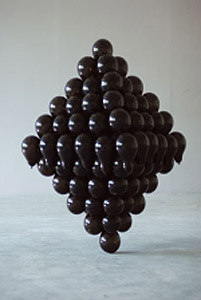
| HOME |
| NERVE |
| REVIEWS |
| ARCHIVE |
| EVENTS |
| LINKS |
| ABOUT US |
| CONTRIBUTORS |
| BACK ISSUES |
| CONTACT US |
 Bloomberg
New Contemporaries 2008
Bloomberg
New Contemporaries 2008
Selected by Richard Billingham, Ceal Floyer and Ken Lum
Blade Factory
& Coach Shed, Greenland Street
20th September – 22nd November 2008 (Tue-Sat 12-6pm)
Reviewed by Adam Ford
A Google of Bloomberg New Contemporaries shows that the Guardian called the 2003 version ‘a depressing welter of gimmickry, infantilism and juvenile ego-flexing’. Indeed, I called the 2006 exhibition a ‘gallery of sighs, where perfect form combines with emptiness and lack of original thought to produce an exhibition of horrific mediocrity’. What is there to add in 2008? Well, not much really, so how about some attempted analysis and a look at some (slightly) highlights alongside (very) lowlights?
The New Contemporaries exhibitions are aimed at showcasing the work of young artists who are at (or just out of) art school, and it has come to Liverpool for every Biennial so far. The overwhelming bulk of the art on display is flawlessly executed, yet emotionally and intellectually unaffecting; nondescript stuff in every form of visual media, seemingly unconnected to human existence itself. On one side, a large canvas filled with blackness, except for a few tiny scrapes of white. On another, a couple of wigs in a box tremble slightly. The overall impact is profoundly depressing. Whose idea of culture is this? What are we looking at here?
Well, to be frank, we are looking at products of art school training. We are looking at explorations of form and technique, with little care for content. We are looking at the work of people who – if they have anything interesting to offer – think they’d best keep it to themselves, or at least out of their art. These artists may still be young, in their mid-to-late twenties, but did they dream of creating stuff like this when they were children? Probably not. Hopefully not. If so, they moved in very rarefied circles.
Of course, there are some exhibits that merit attention. In particular, ‘It happened in the corner’ by littlewhitehead held my interest for a few minutes, starting when I caught a glimpse of what I imagined was a huddle of people around something in – you guessed it – the corner. My first thought was ‘oh, they’ve found something interesting to look at’. My second was ‘hang on, surely there can’t be that many visitors in that area, there’s hardly anyone else here’. My third was ‘oh, it’s a piece of artwork’. So, watched by the CCTV no doubt, I spent some time trying to peer over the heads of the plaster and wax crowd. Even though I’m six foot two, I still had to stand on tippy toes to glimpse…an empty white podium. 'It' is nothing. Oh well, that’s postmodernism for you.
Jason Underhill’s ‘Jessie Lives’ is also intriguing in a vaguely unsettling way. A video shows Jessie talking at the camera about her problematic social life and hopes for ‘new friends’ in a fragile and slightly naïve way. She wants to meet someone who won’t mind standing in the rain with her to catch a glimpse of Robert Smith from The Cure. She’s met the person holding the camera, and they are alone together. What is going to happen, and why am I worried even though I know it’s only acting?
Sitting in the bleak and disintegrating area on ‘the wrong side’ of the road from Liverpool’s former docks, this exhibition is like an alienating invasion. In a sense, it is the perfect metaphor for Capital of Culture and corporate ideas of post-industrial regeneration, sitting there totally divorced from the day-to-day experience of local people’s lives, and the unfolding economic crisis. Do people in the nearby Cains factory make art?
As I said in 2006, it can't go on like this, and surely it won't. I mean it.
There are more exhibitions in the A Foundation building, including works by seven Korean artists and Manuel Vason.